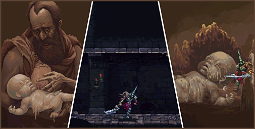Blasphemous 2: A Bloody Brilliant Metroidvania
From the very first cutscene of the long-awaited sequel to The Game Kitchen’s fantastic metroidvania, I knew this would be an exceptional game – and one that’s perfectly suited to the Nintendo Switch. If you enjoyed Hollow Knight, you’ll find much to adore here, and even if you haven’t, Blasphemous 2 is well worth your attention.
There’s a lot to like about Blasphemous 2, from its fantastic atmosphere and progression, to the excellent music, and improved controls and platforming. But, above all, I love how The Game Kitchen has managed to iterate on the metroidvania format without losing what made the original Blasphemous special.
Blasphemous 2 improves on the original in almost every way, especially with regards to controls. The platforming in the first game felt good, but it wasn’t quite as fluid as I’d have liked. Blasphemous 2 feels like a step up in every way – the controls are tighter, there’s more weight to your character, and boss fights are more engaging. It’s still not quite up there with games like Hollow Knight, but it’s close.
There are also a few new mechanics that take the “loadout” system from the first game to another level. The first is “favors,” which give you new ways to interact with the environment. The second is multiple weapons, which allow you to change up your attacks mid-fight. Neither is game-changing, but they add a level of strategy that I really appreciate.
The gameplay is largely the same as the first game, but even minor improvements to the way the character moves and fights is enough to make a huge difference. It’s still very much a metroidvania, with a distinct lack of hand-holding and backtracking, but Blasphemous 2 feels much more fluid and fun than the first.
It’s not all perfect, however. Some players report that the cutscenes in Blasphemous 2 are a bit of a downgrade from the first game, and I have to agree. The voice acting is still excellent, and the dialogue is still great, but the cutscene animations themselves are pretty stiff, and the art style overall is a bit off-putting for me. It’s a matter of subjective taste, of course, but I find it a bit too “pretentious” for my tastes.
The other big criticism I’ve seen is that the level design in Blasphemous 2 makes it far too easy to backtrack, leading to the game feeling longer than it should. It’s certainly true that the levels in Blasphemous 2 feel more labyrinthine than the first game, but I didn’t find this to be a huge problem. If anything, I found the first game to be a bit too linear – Blasphemous 2 at least offers the illusion of choice.
Blasphemous 2: A True Metroidvania Experience
Blasphemous does qualify as a metroidvania, and I’m happy to defend that statement. Sure, there’s no morph ball, but the first game had upgrades, a non-linear map, and an emphasis on exploration. Blasphemous 2 improves on all of these things, and the level design is still great.
It’s worth noting that the upgrade system from the first game has been completely changed. In the first game, you earned “grist” from killing enemies, which you could use to purchase upgrades for your main weapon. Now, you’re given a choice of “bloods” to equip at the beginning of each level, which grant you access to new skills and attacks. Each blood has a unique meter, draining as you use its associated skill. It’s a bit confusing at first, but it’s a fun way to build your character over the course of the game.
The other big change is that Blasphemous 2 is portable. I played it on PC, and I’m happy to report that it holds up just as well on the Nintendo Switch. While the performance is a bit worse on my Surface Go, it’s still perfectly playable, and I’m sure it’ll perform much better on the more powerful Nintendo Switch models.














